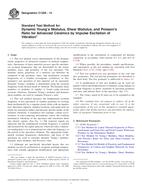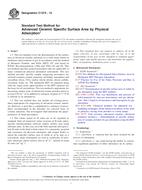Potřebujeme váš souhlas k využití jednotlivých dat, aby se vám mimo jiné mohly ukazovat informace týkající se vašich zájmů. Souhlas udělíte kliknutím na tlačítko „OK“.
ASTM C1291-00a(2010)
Standard Test Method for Elevated Temperature Tensile Creep Strain, Creep Strain Rate, and Creep Time-to-Failure for Advanced Monolithic Ceramics (Includes all amendments And changes 10/12/2016).
Automaticky přeložený název:
Standardní zkušební metoda pro zahřáté tahu Creep kmen, Creep rychlost deformace, a Creep Time-to-selhání pro pokročilé monolitické keramiky
NORMA vydána dne 1.6.2010
Informace o normě:
Označení normy: ASTM C1291-00a(2010)
Poznámka: NEPLATNÁ
Datum vydání normy: 1.6.2010
Kód zboží: NS-10530
Počet stran: 15
Přibližná hmotnost: 45 g (0.10 liber)
Země: Americká technická norma
Kategorie: Technické normy ASTM
Kategorie - podobné normy:
Ostatní normy týkající se keramiky
Keramika pro pokrokové technologie
Anotace textu normy ASTM C1291-00a(2010) :
Keywords:
advanced ceramics, creep, monolithic ceramics, tensile, time-to-failure, Advanced ceramics, Creep, Creep strain rate, Elevated temperature tests, Monolithic advanced ceramics, Strain testing, Tensile properties/testing--ceramics, Time-to-failure (TTF), ICS Number Code 81.060.99 (Other standards related to ceramics), 81.060.30 (Advanced ceramics)
Doplňující informace
| Significance and Use | ||||||||||||||||||||||||||
|
Creep tests measure the time-dependent deformation under load at a given temperature, and, by implication, the load-carrying capability of the material for limited deformations. Creep-rupture tests, properly interpreted, provide a measure of the load-carrying capability of the material as a function of time and temperature. The two tests compliment each other in defining the load-carrying capability of a material for a given period of time. In selecting materials and designing parts for service at elevated temperatures, the type of test data used will depend on the criteria for load-carrying capability that best defines the service usefulness of the material. This test method may be used for material development, quality assurance, characterization, and design data generation. High-strength, monolithic ceramic materials, generally characterized by small grain sizes (<50 μm) and bulk densities near their theoretical density, are candidates for load-bearing structural applications at elevated temperatures. These applications involve components such as turbine blades which are subjected to stress gradients and multiaxial stresses. Data obtained for design and predictive purposes should be obtained using any appropriate combination of test methods that provide the most relevant information for the applications being considered. It is noted here that ceramic materials tend to creep more rapidly in tension than in compression (1, 2, 3). This difference results in time-dependent changes in the stress distribution and the position of the neutral axis when tests are conducted in flexure. As a consequence, deconvolution of flexural creep data to obtain the constitutive equations needed for design cannot be achieved without some degree of uncertainty concerning the form of the creep equations, and the magnitude of the creep rate in tension vis-a-vis the creep rate in compression. Therefore, creep data for design and life prediction should be obtained in both tension and compression, as well as the expected service stress state. |
||||||||||||||||||||||||||
| 1. Scope | ||||||||||||||||||||||||||
|
1.1 This test method covers the determination of tensile creep strain, creep strain rate, and creep time-to-failure for advanced monolithic ceramics at elevated temperatures, typically between 1073 and 2073 K. A variety of specimen geometries are included. The creep strain at a fixed temperature is evaluated from direct measurements of the gage length extension over the time of the test. The minimum creep strain rate, which may be invariant with time, is evaluated as a function of temperature and applied stress. Creep time-to-failure is also included in this test method. 1.2 This test method is for use with advanced ceramics that behave as macroscopically isotropic, homogeneous, continuous materials. While this test method is intended for use on monolithic ceramics, whisker- or particle-reinforced composite ceramics as well as low-volume-fraction discontinuous fiber-reinforced composite ceramics may also meet these macroscopic behavior assumptions. Continuous fiber-reinforced ceramic composites (CFCCs) do not behave as macroscopically isotropic, homogeneous, continuous materials, and application of this test method to these materials is not recommended. 1.3 The values in SI units are to be regarded as the standard (see ). 1.4 This standard does not purport to address all of the safety concerns, if any, associated with its use. It is the responsibility of the user of this standard to establish appropriate safety and health practices and determine the applicability of regulatory limitations prior to use. |
||||||||||||||||||||||||||
| 2. Referenced Documents | ||||||||||||||||||||||||||
|
Podobné normy:
Historická
1.8.2013
Historická
1.1.2014
Historická
1.6.2010
Historická
1.8.2012
Historická
1.12.2010
Historická
1.12.2010



 ASTM C1239-13
ASTM C1239-13 ASTM C1259-14
ASTM C1259-14 ASTM C1273-05(2010)..
ASTM C1273-05(2010).. ASTM C1274-12
ASTM C1274-12 ASTM C1275-10
ASTM C1275-10 ASTM C1292-10
ASTM C1292-10
 Cookies
Cookies
